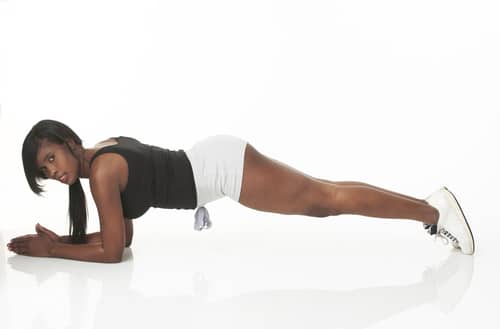
The Benefits of Planks
Planks are an isometric exercise, meaning you hold a position against gravity for a period of time rather than actively contracting a muscle against resistance. There are various types of planks and plank variations, but the most common is the front plank where you hold your body in a push-up position with your elbows on the mat instead of your hands. Planks strengthen your abdominal and back muscles at the same time, unlike crunches that only work your abs. Many people need planks because they fail to compensate for abdominal exercises by doing back exercises. This can create muscle imbalances. Planks help you achieve a more balanced core.
With the plank, you’re activating muscles in your back and around your spine, but you’re also targeting the rectus abdominis muscles that run vertically down each side of your tummy as well as the deeper transverse abdominus. The transverse abdominus is difficult to target with conventional ab exercises. You’re also activating a variety of stabilizing muscles including stabilizers in your back like your traps and rhomboids as well as stabilizers in your shoulders, pecs, glutes, and quads. You’re covering a lot of territory when you do planks.
The beauty of planks is they strengthen your entire core region. That’s important since most of the movements you do in sports and in everyday life originate from or involve your core. Having a strong core improves your balance and stability and makes you less prone to falls. By strengthening the muscles in your back, planks make you less susceptible to pain due to back strains and injuries. Having a strong core also pulls everything in like a girdle, making you look slimmer and more toned.
Planks Have Other Benefits Too
Planks increase flexibility by stretching out the muscles in your back, shoulders, and hamstrings. In addition, planks help with another problem – bad posture – by strengthening your core. Weak core muscles cause you to slouch and that alters your silhouette, making you look less toned and defined. One of the fastest ways to look leaner is to improve your posture.
Do You Do Planks Correctly?
It’s easy to use bad form when doing planks. Here’s how to do one correctly. Get into the push-up position with your forearms on the mat in line with your shoulders. You should be on your toes. Hold this position while keeping a straight line from your head to your toes. Avoid lifting your buttocks or letting your hips sag towards the ground. Squeeze your glutes and pull your belly button towards your spine as you hold the position. Don’t be surprised if you shake a little bit when you first start out. Stay in this position until you can no longer maintain good form.
Plank Variations
Once you’ve mastered the front plank, there are a number of variations on the front plank. You can do a front plank with straight arms, add alternating leg lifts or do spiderman planks or walking planks. This makes the move more dynamic and adds an additional challenge. Then there are side planks with variations such as side planks with oblique twists, with side crunches, with hip dips or leg lifts.
To work on balance, place your toes or elbows on a stability ball and hold the plank position. Make sure you’ve mastered basic planks before trying this variation. You can also reverse the move by doing reverse planks and reverse planks with leg lifts. Reverse planks strengthen your arms, shoulders, and wrists while stretching the front of your body. Plank walk-outs are another dynamic variation that is a good warm-up for the arms, shoulders, and core.
Can You Top This?
Think you’re good at doing planks? Bet you can’t top this one. According to Wikipedia, the world record for holding the plank position is 3 hours, 7 minutes and 15 seconds. You might have to work up to that, huh? Even if you can’t hold a plank for 3 hours plus, you’ll still get the benefits doing them for shorter periods of time if you do them consistently. Make them part of your workout and reap the benefits of a stronger core.
References:
Mayo Clinic. “Core Exercises: Why You Should Strengthen Your Core Muscles”
Related Articles By Cathe:
How Long Should You Hold a Plank?
Hate Planks? Here’s Why You Should Do Them Anyway
Abdominal Training: How Often Should You Train Your Abs?
4 Signs That Your Core Muscles Are Weak
4 Ways to Add More Core Work to Your Workouts
Isometric vs. Isotonic Exercises: What’s the Difference?

